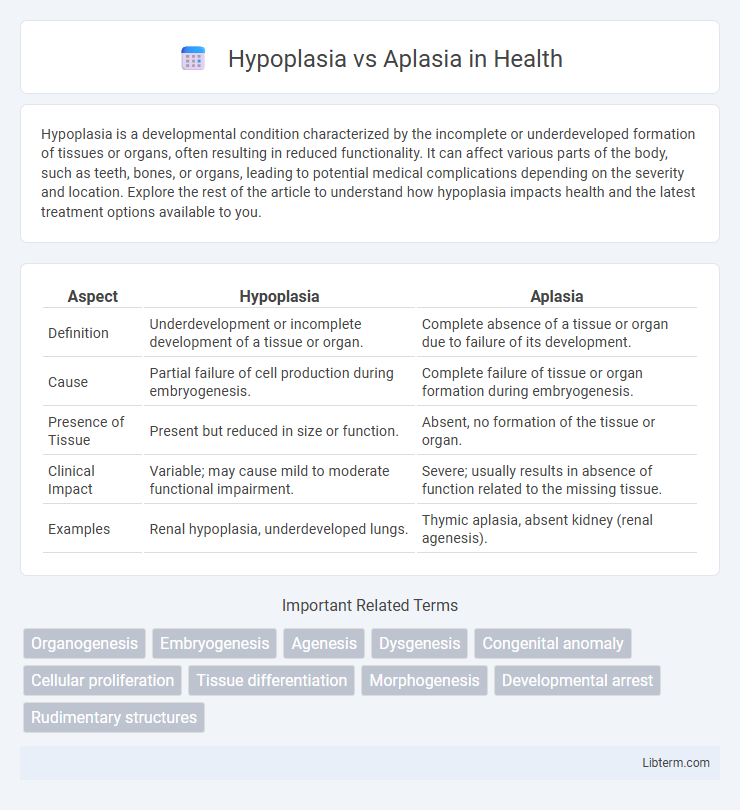Hypoplasia is a developmental condition characterized by the incomplete or underdeveloped formation of tissues or organs, often resulting in reduced functionality. It can affect various parts of the body, such as teeth, bones, or organs, leading to potential medical complications depending on the severity and location. Explore the rest of the article to understand how hypoplasia impacts health and the latest treatment options available to you.
Table of Comparison
| Aspect | Hypoplasia | Aplasia |
|---|---|---|
| Definition | Underdevelopment or incomplete development of a tissue or organ. | Complete absence of a tissue or organ due to failure of its development. |
| Cause | Partial failure of cell production during embryogenesis. | Complete failure of tissue or organ formation during embryogenesis. |
| Presence of Tissue | Present but reduced in size or function. | Absent, no formation of the tissue or organ. |
| Clinical Impact | Variable; may cause mild to moderate functional impairment. | Severe; usually results in absence of function related to the missing tissue. |
| Examples | Renal hypoplasia, underdeveloped lungs. | Thymic aplasia, absent kidney (renal agenesis). |
Introduction to Hypoplasia and Aplasia
Hypoplasia is characterized by the underdevelopment or incomplete formation of an organ or tissue, resulting in reduced size and functionality, while aplasia refers to the complete absence or failure of an organ or tissue to develop. Both conditions are congenital anomalies with varying clinical implications depending on the affected structure, such as bone marrow hypoplasia leading to decreased blood cell production or renal aplasia causing absent kidney formation. Understanding the distinctions between hypoplasia and aplasia aids in accurate diagnosis and management in fields like hematology, nephrology, and developmental biology.
Definitions: Hypoplasia vs. Aplasia
Hypoplasia refers to the underdevelopment or incomplete development of an organ or tissue, resulting in a reduced size or functionality. Aplasia is the complete absence of an organ or tissue due to failure in its development during the embryonic stage. Both conditions are congenital anomalies but differ fundamentally in the presence (hypoplasia) or absence (aplasia) of the anatomical structure.
Embryological Origins
Hypoplasia results from incomplete development of an organ or tissue during embryogenesis, leading to underdeveloped structures due to reduced cell proliferation or differentiation. Aplasia arises from a failure in the embryonic precursor cells to form the organ primordium, causing complete absence of the tissue or organ. Both conditions reflect disruptions in early embryological signaling pathways and gene expression critical for organogenesis.
Causes and Risk Factors
Hypoplasia occurs due to incomplete development or underdevelopment of tissues or organs, often linked to genetic mutations, nutrient deficiencies, or prenatal exposure to toxins. Aplasia results from a complete failure of an organ or tissue to develop, typically caused by severe genetic abnormalities, environmental insults during critical embryonic stages, or teratogenic agents. Both conditions are influenced by maternal health factors, including infections, drug use, and inadequate prenatal care, which increase the risk of developmental anomalies.
Clinical Manifestations
Hypoplasia presents with underdeveloped tissues or organs manifesting as reduced size or function, often detectable through imaging or physical examination. Aplasia involves the complete absence of an organ or tissue, resulting in a more severe lack of function and noticeable clinical deficits from birth. Both conditions may lead to complications depending on the affected organ system, such as respiratory issues in lung hypoplasia or immunodeficiency in aplastic bone marrow.
Diagnostic Approaches
Diagnostic approaches for hypoplasia and aplasia primarily involve imaging techniques like MRI and ultrasound to assess tissue development and identify underdeveloped or absent structures. Histopathological examination further clarifies cellular differentiation and presence of residual tissue, providing definitive diagnosis when imaging is inconclusive. Genetic testing may be employed to detect underlying mutations or syndromes associated with congenital tissue malformations.
Common Disorders Associated with Hypoplasia
Hypoplasia is often linked to disorders such as enamel hypoplasia, affecting tooth development, and pulmonary hypoplasia, which impairs lung function in newborns. In contrast, aplasia involves complete absence of an organ or tissue, commonly seen in conditions like aplastic anemia where bone marrow fails to produce blood cells. Understanding these distinctions aids in diagnosing congenital anomalies and tailoring appropriate medical interventions.
Conditions Linked to Aplasia
Aplasia is often linked to severe congenital conditions such as aplastic anemia, where bone marrow fails to produce sufficient blood cells, and organs like the kidney or thymus fail to form entirely, leading to critical functional deficiencies. In contrast to hypoplasia, which signifies underdevelopment, aplasia indicates complete absence of an organ or tissue, resulting in more profound clinical implications. Common aplasia-associated syndromes include Severely Combined Immunodeficiency (SCID) and renal agenesis, both characterized by the failure of essential organ development.
Treatment Options and Management
Treatment options for hypoplasia often involve monitoring and supportive therapies to enhance the function of underdeveloped tissues, with physical therapy or medication tailored to the specific organ affected. Aplasia usually requires more intensive interventions such as surgical reconstruction or organ transplantation due to the complete absence of tissue development. Management strategies emphasize early diagnosis, multidisciplinary care, and personalized rehabilitation plans to improve patient outcomes in both conditions.
Prognosis and Long-term Outcomes
Hypoplasia involves underdevelopment of an organ or tissue, often allowing partial function and a generally better prognosis with variable long-term outcomes depending on severity and treatment. Aplasia signifies complete absence of an organ or tissue, typically leading to more severe functional deficits and a poorer prognosis, often requiring lifelong medical intervention or supportive care. Early diagnosis and specialized management improve quality of life and long-term survival rates for both conditions.
Hypoplasia Infographic

 libterm.com
libterm.com